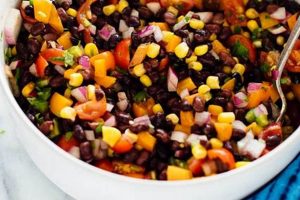The preparation of dishes that exclude all animal products, utilizing small, white legumes, defines a specific culinary niche. This approach to food preparation allows for diverse applications, ranging from hearty soups and stews to creamy dips and spreads. For example, a chili, free from meat and dairy, relies on the starchiness of the aforementioned legumes for its body and texture, incorporating vegetables and spices for flavor.
Adopting this particular method of cooking offers several advantages. It provides a source of plant-based protein and fiber, contributing to a balanced diet. Furthermore, it aligns with ethical and environmental considerations related to animal welfare and sustainable food production. Historically, dishes centered around these legumes have been a staple in many cultures, offering an economical and nutritious food source.
Further discussion will delve into various techniques for effectively utilizing this legume in a plant-based context. Specific recipes demonstrating versatility and nutritional value, as well as tips for optimal preparation and flavor enhancement, will be presented.
Preparation Guidance for Plant-Based Dishes Using Small White Legumes
Effective utilization of these legumes in entirely plant-derived cuisine necessitates adherence to certain procedural recommendations to maximize flavor, texture, and nutritional bioavailability.
Tip 1: Soaking is Essential: Immersion of the legumes in water for a minimum of eight hours prior to cooking rehydrates them, reducing cooking time and mitigating the occurrence of digestive discomfort associated with oligosaccharides.
Tip 2: Cooking Liquid Matters: Employ vegetable broth, infused with aromatic herbs such as thyme and bay leaf, instead of plain water. This imparts a more nuanced flavor profile to the final product. Avoid adding salt until the legumes are fully cooked, as salt can toughen their outer skins.
Tip 3: Spice Integration: Incorporate spices, such as smoked paprika, cumin, and chili powder, early in the cooking process. This allows the flavors to fully meld with the legumes, creating a more complex and satisfying taste.
Tip 4: Acidic Balancing: The addition of a small amount of acidic ingredient, like tomato paste or lemon juice, near the end of cooking can brighten the flavor and enhance the overall taste profile. However, excessive amounts can hinder softening of the legumes.
Tip 5: Texture Control: Achieve desired consistency by varying cooking time. For stews and soups, slightly overcooked legumes contribute to a thicker, creamier texture. For salads, retain a firmer consistency by reducing cooking duration.
Tip 6: Fat Enhancement: A drizzle of high-quality olive oil or a swirl of plant-based cream at the time of serving enriches the dish, adding a layer of richness and complexity. Consider using cold-pressed oils for heightened flavor.
Tip 7: Batch Cooking and Storage: Prepare larger quantities and store excess cooked legumes in an airtight container in the refrigerator for up to five days, or freeze for extended preservation. This facilitates quick meal preparation throughout the week.
Adherence to these guidelines ensures optimal flavor, texture, and digestibility, thereby maximizing the culinary potential of small white legumes in plant-based applications. Mastering these simple techniques elevates culinary outcomes.
The subsequent sections will explore detailed recipes illustrating these techniques in practical applications.
1. Plant-Based Protein
The incorporation of plant-based protein is a central tenet of dishes featuring small, white legumes, ensuring adequate nutrient intake within a framework that excludes animal products. This focus addresses the protein requirements of individuals adhering to vegan dietary guidelines.
- Amino Acid Profile
While legumes provide substantial protein, their amino acid profiles are not complete in the same manner as animal-derived proteins. They are often limited in methionine. Therefore, recipes frequently incorporate complementary protein sources, such as grains (rice, quinoa) or seeds, to ensure all essential amino acids are consumed. This is essential for bodily functions.
- Protein Content Quantification
A single serving of dishes prepared with small, white legumes can contribute significantly to the daily recommended protein intake. Measuring and understanding protein density per serving allows for accurate dietary planning and helps individuals meet their nutritional requirements without animal products. For example, a cup of cooked white legumes contains approximately 15 grams of protein.
- Protein Digestibility Corrected Amino Acid Score (PDCAAS)
PDCAAS measures the quality of a protein based on its amino acid requirements and human digestibility. While legumes generally have a lower PDCAAS than animal proteins, proper preparation techniques, such as soaking and cooking, can improve protein digestibility and bioavailability. Combining legumes with other plant-based foods further enhances protein quality.
- Role in Muscle Synthesis and Satiety
Protein is crucial for muscle synthesis, repair, and overall body maintenance. Plant-based protein from legumes contributes to these processes, albeit potentially requiring larger quantities to achieve equivalent results compared to animal protein. Furthermore, the high fiber content in legumes promotes satiety, aiding in weight management and regulating blood sugar levels.
Therefore, optimizing protein intake from small, white legume based recipes is not solely about quantity but also about quality, bioavailability, and the strategic combination with other plant-based foods. Understanding these nuances enables the creation of nutritionally complete and satisfying plant-based meals.
2. Dietary Fiber Source
Dishes featuring small, white legumes, prepared without animal products, offer a significant contribution to dietary fiber intake. The inherent fiber content of these legumes plays a crucial role in promoting digestive health and overall well-being.
- Soluble and Insoluble Fiber Composition
These legumes contain both soluble and insoluble fiber. Soluble fiber forms a gel-like substance in the digestive tract, aiding in cholesterol reduction and blood sugar stabilization. Insoluble fiber adds bulk to the stool, facilitating regular bowel movements and preventing constipation. A balanced intake of both types of fiber is essential for optimal digestive function. For example, soluble fiber helps manage cholesterol, while insoluble fiber ensures regular bowel movements.
- Impact on Gut Microbiota
The fiber present in these legumes serves as a prebiotic, nourishing beneficial gut bacteria. A healthy gut microbiome is linked to improved immune function, reduced inflammation, and enhanced nutrient absorption. The fermentation of fiber by gut bacteria produces short-chain fatty acids, which have various health benefits, including improved gut barrier function. The fiber promotes the growth of Bifidobacteria and Lactobacilli, which help suppress harmful bacteria.
- Role in Satiety and Weight Management
High-fiber foods, such as dishes centered around small, white legumes, promote satiety by slowing down digestion and increasing feelings of fullness. This can aid in weight management by reducing overall calorie intake. Fiber also helps regulate appetite and prevents overeating by influencing the release of satiety hormones. Dishes that are high in fiber make you feel fuller and may help you eat less.
- Effect on Blood Sugar Regulation
Dietary fiber helps to slow the absorption of glucose into the bloodstream, preventing rapid spikes in blood sugar levels. This is particularly beneficial for individuals with diabetes or insulin resistance. The consumption of high-fiber meals can improve insulin sensitivity and reduce the risk of developing type 2 diabetes. Stabilized blood sugar levels contributes to consistent energy levels.
Integrating dishes featuring small, white legumes into a vegan dietary pattern ensures a consistent and ample supply of dietary fiber, contributing to improved digestive health, weight management, and blood sugar regulation. The versatility of these legumes allows for diverse culinary applications that cater to various preferences while maintaining their nutritional benefits. Regular consumption supports overall metabolic health and disease prevention. These dishes are valuable for promoting a healthy digestive system and helps with a balanced diet.
3. Versatile Culinary Applications
The adaptability of small, white legumes significantly broadens the scope of plant-based cooking. Their neutral flavor profile and textural malleability render them suitable for a diverse range of preparations. As a result, these legumes form a core ingredient in numerous dishes spanning various cuisines, effectively demonstrating their adaptability. Their capacity to absorb flavors and transform in texture directly influences the success of recipes designed within vegan culinary guidelines.
Consider, for example, their use in thickening vegetable-based soups. The pureed form imparts creaminess without the need for dairy products. Conversely, whole legumes contribute substance to stews, providing a hearty component. Further demonstrating utility, these legumes can be transformed into plant-based dips and spreads, offering alternatives to dairy-based counterparts. Moreover, they can be incorporated into baked goods, contributing moisture and binding properties to recipes that exclude eggs. These instances showcase the practical applications. The adaptability provides diverse menu options.
In summary, the extensive applicability of these legumes within the plant-based realm is central to their sustained culinary relevance. The capacity to be incorporated into vastly differing dishes addresses diverse dietary needs and preferences, contributing to the sustained adoption of dishes featuring small, white legumes. While specific applications require adjustments to preparation techniques, the fundamental versatility remains a consistent asset. Their widespread use shows their value in plant-based diets.
4. Nutritional Value Retention
The preservation of essential nutrients during the preparation of dishes featuring small, white legumes is paramount within the context of plant-based diets. Optimizing cooking methods and ingredient pairings can substantially influence the bioavailability and overall retention of vitamins, minerals, and other vital compounds. Understanding factors that can degrade or enhance nutrient content is critical to maximizing health benefits.
- Impact of Cooking Methods on Nutrient Stability
Boiling, steaming, pressure cooking, and sauting exert differential effects on nutrient retention. Water-soluble vitamins, such as vitamin C and B vitamins, are susceptible to leaching during prolonged boiling. Steaming or pressure cooking can minimize nutrient loss due to shorter cooking times and reduced water exposure. Sauting in healthy fats can enhance the absorption of fat-soluble vitamins, such as vitamins A, D, E, and K. Choosing the appropriate cooking technique is fundamental for optimizing nutrient preservation. Minimizing water exposure during cooking preserves nutrients.
- Role of Ingredient Combinations in Enhancing Nutrient Bioavailability
Strategic ingredient pairings can enhance the bioavailability of certain nutrients present in dishes featuring small, white legumes. For instance, combining these legumes with vitamin C-rich vegetables, such as bell peppers or tomatoes, can improve the absorption of non-heme iron, which is the form of iron found in plant-based foods. Similarly, incorporating sources of healthy fats, like avocado or olive oil, can facilitate the absorption of fat-soluble vitamins. Careful selection of accompanying ingredients is essential for maximizing nutrient uptake. Vitamin C helps absorb iron in plant-based food.
- Influence of Processing and Storage on Nutrient Degradation
Excessive processing and improper storage conditions can lead to significant nutrient degradation in legumes and other plant-based ingredients. Over-milling grains, prolonged exposure to heat or light, and extended storage periods can diminish vitamin and mineral content. Selecting minimally processed ingredients, storing them properly in airtight containers away from direct light, and using them within a reasonable timeframe can help mitigate nutrient loss. Minimally processed ingredients have the most nutrition.
- Minimizing Anti-Nutritional Factors to Enhance Mineral Absorption
Legumes contain anti-nutritional factors, such as phytates and tannins, which can inhibit the absorption of certain minerals, including iron, zinc, and calcium. Soaking legumes before cooking, sprouting them, or fermenting them can help reduce the levels of these anti-nutritional factors, thereby enhancing mineral bioavailability. Employing these preparation techniques can significantly improve the nutritional value of dishes featuring small, white legumes. Soaking legumes helps remove mineral absorption inhibitors.
In conclusion, conscious attention to cooking methods, ingredient pairings, processing, and storage practices is essential for maximizing nutritional value retention in recipes featuring small, white legumes. By implementing strategies that minimize nutrient loss and enhance bioavailability, one can optimize the health benefits derived from these dishes. Integrating varied strategies helps retain valuable nutrients.
5. Ethical Food Choices
The formulation of dishes using small, white legumes, absent animal products, directly correlates with the principles of ethical food choices. The decision to exclude animal-derived ingredients inherently addresses concerns related to animal welfare, environmental sustainability, and social justice within the food system. The selection of plant-based proteins, like those found in these legumes, serves as a tangible action aligned with these ethical considerations. Specifically, reliance on these dishes mitigates the demand for animal agriculture, a sector often implicated in ethical dilemmas.
The repercussions of conventional animal agriculture extend beyond animal treatment. Environmental degradation, resource depletion, and contributions to greenhouse gas emissions are significantly associated with livestock production. Opting for dishes centered on small, white legumes, conversely, reduces the ecological footprint linked to food consumption. The cultivation of these legumes typically requires less land, water, and energy compared to animal agriculture. Furthermore, these legumes contribute to soil health through nitrogen fixation, reducing the necessity for synthetic fertilizers. The practical significance is evident in a reduced burden on natural resources and minimized environmental impact.
In conclusion, the adoption of recipes featuring small, white legumes represents a tangible ethical stance. Challenges may arise in accessing affordable and diverse plant-based options, requiring continued efforts to promote equitable food systems. However, the core principle remains: plant-based dietary choices, exemplified by dishes centered on small, white legumes, contribute to a more ethical and sustainable food landscape.
6. Sustainable Diet Options
The integration of plant-based proteins, such as small, white legumes, into dietary regimens is increasingly recognized as a sustainable practice. This approach offers potential for mitigating environmental impact while providing essential nutritional components. Recipes centered on these legumes, excluding animal products, exemplify a tangible application of sustainable dietary principles.
- Reduced Carbon Footprint
The production of small, white legumes generates a lower carbon footprint compared to animal agriculture. Livestock production contributes significantly to greenhouse gas emissions through methane production and deforestation. Substituting animal proteins with plant-based alternatives, such as those found in legume-based recipes, diminishes the environmental impact associated with food production. Analysis of carbon footprints often show plant-based diets have significant advantages.
- Efficient Resource Utilization
The cultivation of small, white legumes requires less water and land compared to animal farming. Water scarcity is a growing concern globally, and reducing water consumption in food production is crucial for sustainability. Legumes also contribute to soil health through nitrogen fixation, lessening the demand for synthetic fertilizers. Therefore, they are a viable part of an efficient food system.
- Promoting Biodiversity
Diversifying crop production is essential for maintaining biodiversity in agricultural systems. Over-reliance on a limited number of crops can lead to soil degradation and increased vulnerability to pests and diseases. Incorporating small, white legumes into crop rotations enhances soil health and supports agricultural biodiversity. This promotes resilience in food systems.
- Economic Viability for Farmers
Supporting the cultivation of small, white legumes can create economic opportunities for farmers, particularly in regions where animal agriculture is less sustainable. Diversifying income streams through the production of plant-based proteins can enhance economic resilience and contribute to rural development. Supporting sustainable agriculture ensures a stable food supply.
Recipes centered on small, white legumes represent a practical manifestation of sustainable dietary choices. By embracing these recipes, individuals can actively contribute to reducing their environmental impact while ensuring adequate nutritional intake. Such choices support long-term ecological health and foster a more sustainable food system.
7. Digestibility Enhancement Strategies
Implementing specific methodologies is paramount for optimizing the digestive processing of dishes centered on small, white legumes, particularly within a vegan dietary framework. The intrinsic composition of these legumes presents inherent challenges to digestion, necessitating the application of targeted strategies to mitigate potential gastrointestinal discomfort and maximize nutrient absorption.
- Soaking Prior to Cooking
Extended immersion in water prior to culinary preparation serves to leach oligosaccharides, complex sugars responsible for intestinal gas production. This process, typically lasting eight to twelve hours, significantly reduces the concentration of these compounds, thereby alleviating digestive distress. For example, failure to adequately soak these legumes before cooking frequently results in bloating and flatulence. Soaking is a foundational element in the preparation of these legumes, positively impacting their overall tolerability.
- Thorough Cooking Procedures
Adequate thermal processing is essential to denature proteins and further reduce the presence of oligosaccharides. Under-cooked legumes exhibit heightened resistance to digestive enzymes, prolonging transit time and potentially exacerbating gastrointestinal symptoms. Conversely, complete cooking renders the starches more accessible for enzymatic breakdown, promoting efficient digestion. The desired consistency should be soft and easily mashed, indicating sufficient cellular rupture.
- Enzyme Supplementation
For individuals particularly sensitive to legume consumption, the incorporation of exogenous digestive enzymes may prove beneficial. Alpha-galactosidase, an enzyme specifically targeting oligosaccharides, can be ingested concurrently with dishes containing these legumes to facilitate their breakdown in the intestinal tract. This approach provides an adjunctive measure for mitigating digestive discomfort and enhancing nutrient assimilation.
- Gradual Introduction and Portion Control
Incremental integration of these legumes into the diet allows the digestive system to adapt gradually, fostering increased tolerance. Introducing small portions initially, and slowly increasing serving sizes over time, permits the gut microbiota to adjust to the increased fiber and carbohydrate content. This strategy minimizes the likelihood of abrupt gastrointestinal disturbances associated with rapid dietary alterations. Portion control is crucial at the beginning to avoid digestion problem.
The application of these digestibility enhancement strategies, in conjunction with appropriate recipe formulation, is essential for maximizing the nutritional benefits and minimizing adverse effects associated with the consumption of small, white legumes within a vegan dietary context. Integrating soaking, adequate cooking, enzyme supplementation, and measured introduction contribute significantly to enhanced tolerability and overall digestive well-being.
Frequently Asked Questions
The following questions address common inquiries regarding the preparation and consumption of dishes centered around small, white legumes, excluding all animal products. The intention is to provide clear, concise answers based on established culinary and nutritional principles.
Question 1: Are small, white legumes nutritionally complete as a primary protein source in a plant-based diet?
While small, white legumes offer a substantial source of protein, they are not considered complete proteins on their own. They are relatively low in the amino acid methionine. Combining them with grains, nuts, or seeds ensures intake of all essential amino acids.
Question 2: What preparation techniques most effectively minimize digestive discomfort associated with consuming small, white legumes?
Soaking the legumes for at least eight hours prior to cooking is paramount in reducing oligosaccharides, which contribute to gas production. Additionally, thorough cooking until the legumes are tender facilitates easier digestion.
Question 3: Can dishes featuring small, white legumes be suitable for individuals with specific dietary restrictions, such as gluten intolerance or nut allergies?
Yes, dishes using these legumes can be easily adapted to accommodate various dietary needs. Substituting gluten-free grains and avoiding nuts or seeds when necessary allows for broader consumption.
Question 4: How does the cooking method influence the nutritional value of dishes based on these legumes?
Steaming or pressure cooking helps retain water-soluble vitamins that may be lost during prolonged boiling. Sauteing with healthy fats can enhance the absorption of fat-soluble vitamins. The choice of cooking method directly affects nutrient preservation.
Question 5: What is the most effective way to store cooked small, white legumes to maintain their quality and prevent spoilage?
Cooked legumes should be cooled promptly and stored in airtight containers in the refrigerator for up to five days. For longer storage, freezing is recommended. Proper storage is crucial for preserving texture and preventing bacterial growth.
Question 6: Is there a significant difference in nutritional content between dried and canned small, white legumes?
Dried legumes generally offer a higher nutritional value compared to canned varieties. Canned legumes may contain added sodium and undergo processing that can reduce certain nutrient levels. Rinsing canned legumes before use can help reduce sodium content.
These answers provide a foundation for understanding the preparation and nutritional aspects of dishes featuring small, white legumes in a plant-based context. Further exploration of specific recipes and culinary techniques is recommended for expanding knowledge and application.
Subsequent sections will provide sample recipes and culinary modifications.
Conclusion
The preceding exploration has provided a comprehensive overview of plant-based culinary practices centered around small, white legumes. Key aspects encompassed nutritional considerations, ethical implications, sustainable practices, digestibility enhancement strategies, and versatile application. Furthermore, it addressed common inquiries regarding optimal preparation and storage to maximize both nutritional value and culinary potential.
The information presented serves to inform individuals seeking to incorporate plant-based options into their dietary regimes. Continued refinement of culinary techniques and further research into nutritional aspects will further elevate the role of these legumes in sustainable and ethically conscious food practices. It is incumbent upon informed individuals to utilize this knowledge to promote both personal well-being and broader environmental responsibility.







